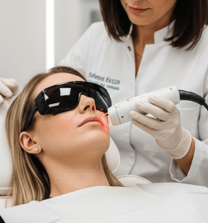Treatment Overview
Anti-Redness Laser Therapy is one of the most frequently used treatments in Korea for persistent redness, flushing, and vascular sensitivity, often associated with rosacea, post-inflammatory erythema, or sensitive skin syndromes. These lasers (commonly Pulsed Dye Laser [PDL], Nd:YAG, and V-Beam Perfecta) target hemoglobin in dilated blood vessels, selectively shrinking them to reduce diffuse redness and visible flushing.
Korean dermatology clinics widely integrate anti-redness lasers as part of skin-soothing programs, often combining them with cooling masks, regenerative serums, and barrier-repair therapies. The approach emphasizes not just redness reduction, but also restoring skin resilience and preventing relapse.
For redness and flushing, Anti-Redness Laser Therapy:
- Reduces visible capillaries and diffuse redness.
- Calms vascular reactivity and flushing.
- Improves overall skin tone uniformity.
- Enhances skin barrier recovery when paired with aftercare.
Purpose & Benefits
- Vascular Targeting: Destroys dilated blood vessels without harming surrounding tissue.
- Redness Reduction: Significantly decreases diffuse erythema and visible capillaries.
- Flushing Control: Helps patients prone to heat-triggered flushing.
- Skin Tone Improvement: Creates more even and balanced complexion.
- Barrier Support: Often combined with soothing infusions for post-laser recovery.
- Long-Term Care: Effective maintenance for rosacea and sensitive skin.
Ideal Candidates
Anti-Redness Laser Therapy in Korea is recommended for:
- Patients with rosacea-related redness and flushing.
- Individuals with post-acne erythema or vascular scarring.
- Those with sensitive skin prone to heat or alcohol flushing.
- Patients seeking non-invasive redness control.
- Adults looking for a clinic-supervised vascular laser program.
Comparison with Other Treatments
- Anti-Redness Lasers (PDL, V-Beam, Nd:YAG): Direct vascular targeting; most effective for persistent redness.
- IPL (Intense Pulsed Light): Broader spectrum, improves redness + pigmentation, but less precise than lasers.
- Topical Anti-Redness Creams (Brimonidine, Oxymetazoline): Temporary vasoconstriction; no long-term vessel reduction.
- Barrier Repair Creams (Panthenol, Centella, Madecassoside): Calm sensitivity but don’t treat vessels.
- Oral Medications (Doxycycline, Beta-blockers): Used in moderate-severe rosacea; systemic side effects possible.
- LED Therapies (Blue/Yellow/Red Light): Soothe inflammation, but limited vascular impact compared to lasers.
Possible Risks & Complications
While considered safe, anti-redness lasers may cause:
- Temporary redness and swelling post-treatment.
- Mild bruising or purpura (especially with PDL).
- Dryness or sensitivity in the first week.
- Rare hyperpigmentation in darker skin types.
Treatment Techniques Used
- Laser Application: PDL, Nd:YAG, or V-Beam applied directly to vascular areas.
- Frequency: 3–5 sessions spaced 3–4 weeks apart for best results.
- Combination Therapy: Paired with cooling masks, barrier infusions, or IPL.
- Clinic Integration: Korean clinics often add cryo-therapy, soothing packs, and LED calming post-laser.
Recovery & Aftercare
- First Week: Redness and swelling subside; capillaries begin shrinking.
- 2–4 Weeks: Visible reduction in flushing and redness.
- Maintenance: Occasional touch-ups to sustain results.
Aftercare Tips:
- Avoid hot saunas, alcohol, and spicy food for 1 week.
- Use fragrance-free moisturizers and sunscreen daily.
- Apply clinic-recommended soothing creams or masks.
- Avoid exfoliation or retinoids for 1–2 weeks post-treatment.
Results & Longevity
- Short-Term (1–2 Weeks): Redness reduced, skin feels calmer.
- Medium-Term (1–2 Months): Flushing episodes decrease, complexion evens out.
- Long-Term: Maintenance every 6–12 months ensures stable results.
Treatment Process in Korea
- Consultation & Diagnosis – Dermatologist assesses type of redness (rosacea, post-acne, vascular).
- Recommendation – Laser type (PDL, Nd:YAG, or V-Beam) chosen for patient’s condition.
- Usage Instruction – Treatment plan (usually 3–5 sessions) explained.
- Clinic Add-Ons – Cooling therapy, LED calming, or soothing infusions post-laser.
- Follow-Up – Maintenance adjusted depending on relapse frequency.
Why Korea is a Top Destination
- Advanced vascular lasers (latest PDL & V-Beam systems).
- Clinics integrate lasers with barrier repair and calming programs.
- Affordable compared to Western dermatology packages.
- Emphasis on sensitive skin care and combination therapies.
- Seoul’s clinics are globally recognized for rosacea and redness management.
Cost Range (Detailed Breakdown)
Pricing for Anti-Redness Laser Therapy in Korea:
- Single Anti-Redness Laser Session (PDL, Nd:YAG, V-Beam): USD 150 – 350.
- Package of 3–5 Sessions: USD 600 – 1,200.
- Consultation Fee: USD 20 – 50.
- Clinic Add-Ons (Cooling mask, barrier infusion, LED therapy): USD 50 – 150.
- Premium Redness Program (Laser + Infusions + Barrier Repair): USD 1,000 – 2,500.
Additional Costs in Korea:
- Aftercare creams (Panthenol, Centella, Propolis): USD 30 – 80.
- Sunscreens for sensitive skin: USD 20 – 50.
💡 Patients often call anti-redness lasers the “vascular reset button”, since they directly shrink dilated vessels and restore a calmer complexion.
Popular Clinics in Seoul
- Oracle Dermatology – V-Beam and Nd:YAG laser programs for rosacea.
- Banobagi Dermatology – Customized redness + barrier repair packages.
- Renewme Skin Clinic – Anti-redness lasers paired with soothing infusions.
- View Plastic & Dermatology – PDL and V-Beam with cooling + LED therapy.
- Chaum Anti-Aging Center – Premium vascular programs with lasers + regeneration serums.




